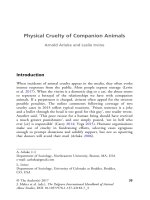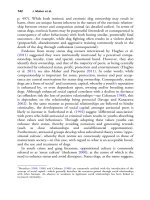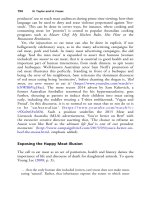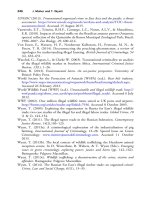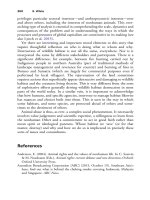The palgrave international handbook of a 268
Bạn đang xem bản rút gọn của tài liệu. Xem và tải ngay bản đầy đủ của tài liệu tại đây (36.17 KB, 1 trang )
264
R. White
privileges particular sectoral interests—and anthropocentric interests—over
and above others, including the interests of nonhuman animals. This overarching type of analysis is essential in comprehending the scale, dynamics and
consequences of the problem and in understanding the ways in which the
processes and pressures of global capitalism are constitutive in its making (see
also Lynch et al. 2015).
Yet there are interesting and important moral elements to this story that
require thoughtful reflection on who is doing what to whom and why.
Destruction of wildlife habitat is not all the same, everywhere. Nor is it
interpreted the same by different stakeholders and participants. There is a
significant difference, for example, between fire burning carried out by
Indigenous people in northern Australia (part of traditional methods of
landscape management and reverence for country) and burning of fires in
Borneo and Sumatra (which are largely for commercial purposes even if
performed by local villagers). The rejuvenation of the land sometimes
requires actions that superficially appear destructive and damaging to wildlife
habitat and the creatures living therein. This is very different from the sorts
of exploitative efforts generally driving wildlife habitat destruction in most
parts of the world today. In a similar vein, it is important to acknowledge
that how humans, and specific agencies, intervene to manage habitat likewise
has nuances and choices built into them. This is seen in the way in which
some habitats, and some species, are protected ahead of others and sometimes to the detriment of others.
Animal abuse is thus, as ever, a complex social phenomenon. It necessarily
involves value judgement and scientific expertise, a willingness to learn from
the nonhuman Other and a commitment to act in good faith rather than
mean spirit or ideological pureness. Whose habitat we ‘save’ (or for that
matter, destroy) and why and how we do so is implicated in precisely these
sorts of issues and conundrums.
References
Anderson, E. (2004). Animal rights and the values of nonhuman life. In C. Sustein
& M. Nussbaum (Eds.), Animal rights: current debates and new directions. Oxford:
Oxford University Press.
Australian Broadcasting Corporation [ABC] (2015, October 19). Southeast Asia’s
haze: find out what is behind the choking smoke covering Indonesia, Malaysia
and Singapore. ABC News.
